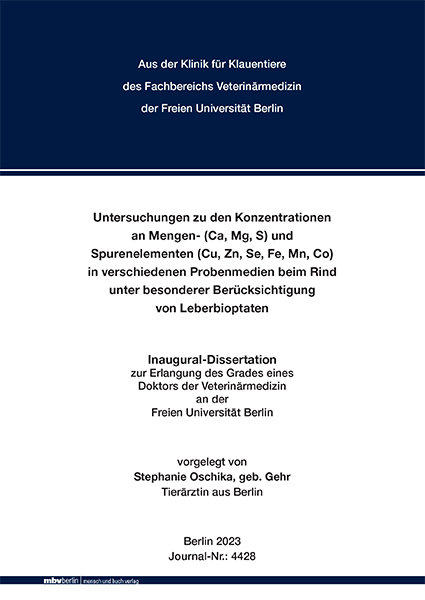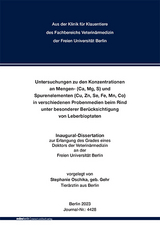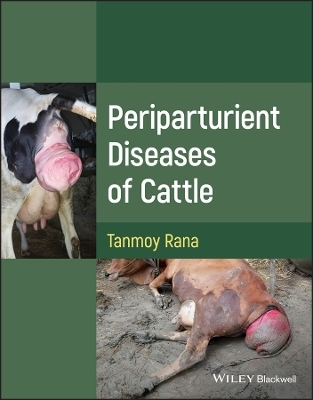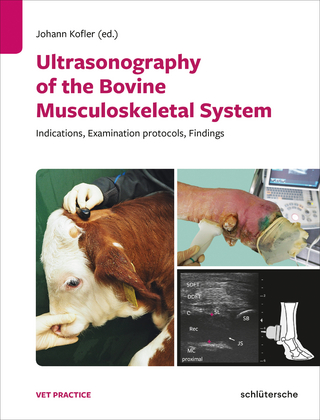Untersuchungen zu den Konzentrationen an Mengen- (Ca, Mg, S) und Spurenelementen (Cu, Zn, Se, Fe, Mn, Co) in verschiedenen Probenmedien beim Rind unter besonderer Berücksichtigung von Leberbioptaten
Seiten
2024
|
1. Auflage
Mensch & Buch (Verlag)
978-3-96729-238-1 (ISBN)
Mensch & Buch (Verlag)
978-3-96729-238-1 (ISBN)
"Investigations of mineral- (Ca, Mg, S) and trace element-concentrations (Cu, Zn, Se, Fe, Mn, Co) in cattle in different sample media with special consideration of liver biopsies"
The monitoring of mineral- and trace element-supply should be integrated into the stock management of the dairy herds. Unspecific symptoms such as reduced fertility, growth and performance depressions can be the result of imbalances in mineral balance. However, these are always only suspected diagnoses if no suitable diagnostics are initiated. Choosing the right sample medium is essential in order to be able to make the most accurate statement on the supply status.
The aim of this study is to examine and assess liver as a test medium for evaluating the mineral- and trace element-supply in dairy cattle. For this purpose, hepatic concentrations are compared with other media. The suitability of the different substrates for the respective element is then assessed in order to provide information about the supply situation.
Therefore, many samples were collected over a period of two years in Brandenburg, Saxony, Saxony-Anhalt, Thuringia and Mecklenburg-Western Pomerania. Sample materials consisted of blood, faeces, liver, hair and feed. The data includes 355 individual and 30 pool samples from clinically healthy Holstein Frisian. The sample values for media faeces, urine, whole blood, animal feed and hair are made up of pooled samples from 10 tested animals. A feed analysis was carried out for the TMR and concentrations of bulk elements calcium, magnesium, sulfur. The trace elements copper, zinc, selenium, iron, manganese and cobalt were determined using ICP-OES and ICP-MS.
For the elements magnesium, copper, zinc, selenium, iron, manganese und cobalt, the group of calves differs significantly from the studied groups of lactating and non-lactating cows. This is of particular importance as there is little literature to assess concentrations in calves. For the elements calcium, magnesium and sulfur, the content in the liver can only be used to a limited extent to assess the metabolic supply situation, so that the liver biopsy does not bring any added value. A more reliable interpretation can be achieved by evaluating and combining it with other substrates or blood values. For copper, liver biopsy is the method of choice for assessing the metabolic supply situation, but should be supplemented by the analysis of TMR and feces for the nutritional supply situation to account for the antagonists. Zinc shows a very high liver concentration, especially in calves. Therefore, the biopsy is the best diagnostic tool for metabolic medium-term care. For selenium, the liver is a similarly sensitive medium as blood. In the context of the biopsy, a good statement can be made about the current supply situation by measuring the concentration, but it does not bring any added value.
Iron can be measured in high concentrations in the liver, especially in calves. In adult cattle, the biopsy is a diagnostic if the TMR has too low an iron content. The result of the iron concentration in the liver biopsy is falsified by the probe`s own blood content, so that a statement is unclear and requires further investigations. For the medium of manganese, liver biopsy is the diagnostic of choice, especially when it comes to intoxication. However, due to the limited data available, the assessment of liver manganese can only be evaluated to a limited extent and requires further analyses. Liver tissue reflects the most accurate result of cobalt concentration. Higher concentrations could be measured in these samples than in the other media examined, which improves an assessment of the metabolic supply situation.
Further investigations are recommended to substantiate the values determined here. This then forms the basis for the development of monitoring profile of the metabolic supply situation in juvenile and adult cattle.
In this study, reference ranges for the individual elements in the liver tissue could be determined. The following table summarizes values in mg/kg for the three groups studied.
Concentrations of the individual elements in the liver tissue for the groups studied in mg/kg TS:
I = Calf, II = lactating, III = non-lactating
Selenium:
I: 0,9 – 1,1 | II: 2,0 – 2,3 | III: 1,3 – 1,7
Manganese:
I: 4,95 – 6,2 | II: 10,2 – 10,6 | III: 7,6 – 8,4
Cobalt:
I: 0,08 – 0,12 | II: 0,26 – 0,28 | III: 0,2 – 0,24
Iron:
I: 466 – 731 | II: 273 – 303 | III: 314 – 405
Zinc:
I: 243 – 360 | II: 99 – 112 | III: 106 – 112
Copper:
I: 153 – 203 | II: 482 – 526 | III: 241 – 326
Calcium:
I: 199 – 312 | II: 251 – 317 | III: 229 – 259
Magnesium:
I: 646 – 802 | II: 636 – 688 | III: 661 – 685
Sulfur:
I: 8202 – 9557 | II: 8153 – 9046 | III: 8146 – 8461 Das Monitoring der Mengen- und Spurenelementversorgung sollte in die Bestandsbetreuung der Milchviehherden integriert werden. Unspezifische Krankheitssymptome wie reduzierte Fruchtbarkeit, Wachstums- und Leistungsdepressionen können die Folge von Dysbalancen im Mineralstoffhaushalt sein. Jedoch sind diese immer nur Verdachtsdiagnosen, wenn keine geeignete Diagnostik eingeleitet wird. Dafür ist die Wahl des richtigen Probemediums wesentlich, um eine möglichst genaue Aussage zum Versorgungsstatus tätigen zu können.
Zielsetzung dieser Arbeit ist es, Leber als Untersuchungsmedium zur Bewertung der Mengen- und Spurenelementversorgung beim Milchrind zu untersuchen und zu beurteilen. Hierfür wird die hepatische Konzentration mit denen in anderen Medien verglichen. Anschließend erfolgt die Beurteilung der Eignung der unterschiedlichen Substrate für das jeweilige Element zur Aussage der Versorgungslage und der untersuchten Gruppen.
Zu diesem Zweck wurden über einen Zeitraum von zwei Jahren Proben in Beständen in Brandenburg, Sachsen, Sachsen-Anhalt, Thüringen und Mecklenburg-Vorpommern gesammelt. Das Probenmaterial bestand aus Blut-, Kot-, Leber-, Haar- und Futterproben. Der Datenpool umfasst 355 Einzel- und 30 Bestandsproben von klinisch gesunden Holstein-Friesian Kühen. Die Probenwerte der Medien Kot, Harn, Vollblut, Futtermittel und Haare setzen sich aus gepoolten Bestandsproben von je 10 Probanden zusammen. Es erfolgte eine Futtermittelanalyse für die TMR und die Konzentrationen der Mengenelemente Kalzium, Magnesium, Schwefel. Die Spurenelemente Kupfer, Zink, Selen, Eisen, Mangan und Kobalt wurden mittels ICP-OES bzw. ICP-MS bestimmt.
Für die Elemente Magnesium, Kupfer, Zink, Selen, Eisen, Mangan und Kobalt unterscheidet sich die Gruppe Kälber signifikant von den untersuchten Gruppen laktierende und nicht laktierende Kühe. Dies ist von besonderer Bedeutung, da bisher wenig Literatur zur Beurteilung der Konzentrationen bei Kälbern vorliegt. Für die Elemente Kalzium, Magnesium und Schwefel kann der Gehalt in der Leber nur bedingt zur Beurteilung der metabolischen Versorgungslage genutzt werden, so dass die Leberbiopsie keinen Mehrwert bringt. Eine zuverlässigere Interpretation kann durch die Auswertung und Kombination mit weiteren Substraten oder der Blutwerte erzielt werden. Für Kupfer ist die Leberbiopsie die Methode der Wahl zur Beurteilung der metabolischen Versorgungslage, sollte jedoch durch die Analyse von TMR und Kot für die nutritive Versorgungslage ergänzt werden, um die Antagonisten zu berücksichtigen. Zink zeigt eine sehr hohe Leberkonzentration, vor allem beim Kalb. Deshalb stellt die Biopsie das beste Diagnostikum zur mittelfristigen metabolischen Versorgung dar.
Für Selen ist die Leber ein ähnlich sensitives Medium wie Blut. Im Rahmen der Biopsie kann durch die Messung der Konzentration eine gute Aussage zur momentanen Versorgungslage getätigt werden, allerdings bringt sie keinen Mehrwert. Eisen kann vor allem bei Kälbern in hohen Konzentrationen in der Leber gemessen werden. Beim adulten Rind ist die Biopsie ein Diagnostikum, wenn die TMR einen zu niedrigen Eisengehalt aufweist. Das Ergebnis der Eisenkonzentration im Leberbioptat wird durch den eigenen Blutgehalt verfälscht, so dass eine Aussage unklar ist und weiterer Untersuchungen bedarf. Für das Medium Mangan ist die Leberbiopsie das Diagnostikum der Wahl, vor allem wenn es um Intoxikationen geht. Jedoch kann wegen der geringen verfügbaren Daten die Beurteilung der Lebermangankonzentration nur eingeschränkt bewertet werden und bedarf weiterer Analysen. Das Lebergewebe spiegelt das genaueste Ergebnis der Kobaltversorgung wider. In diesen Proben konnten höhere Konzentrationen als in den anderen untersuchten Medien gemessen werden, was eine Bewertung der metabolischen Versorgungslage verbessert.
Es sind weitere Untersuchungen zu empfehlen, um die hier ermittelten Werte zu untermauern. Dies stellt dann die Basis für die Entwicklung eines Überwachsungsprofils der metabolischen Versorgungslage beim juvenilen und adulten Rind über die Analyse von Leberbiopsieproben dar.
In dieser Untersuchung konnten Referenzbereiche für die einzelnen Elemente im Lebergewebe bestimmt werden. In der folgenden Tabelle sind die Werte für die drei untersuchten Gruppen in mg/kg zusammengefasst.
Konzentrationen der einzelnen Elemente im Lebergewebe für die untersuchten Gruppen in mg/kg TS:
I = Kalb, II = laktierend, III = nicht laktierend
Selen: I: 0,9 – 1,1 | II: 2,0 – 2,3 | III: 1,3 – 1,7
Mangan: I: 4,95 – 6,2 | II: 10,2 – 10,6 | III: 7,6 – 8,4
Kobalt: I: 0,08 – 0,12 | II: 0,26 – 0,28 | III: 0,2 – 0,24
Eisen: I: 466 – 731 | II: 273 – 303 | III: 314 – 405
Zink: I: 243 – 360 | II: 99 – 112 | III: 106 – 112
Kupfer: I: 153 – 203 | II: 482 – 526 | III: 241 – 326
Kalzium: I: 199 – 312 | II: 251 – 317 | III: 229 – 259
Magnesium: I: 646 – 802 | II: 636 – 688 | III: 661 – 685
Schwefel: I: 8202 – 9557 | II: 8153 – 9046 | III: 8146 – 8461
The monitoring of mineral- and trace element-supply should be integrated into the stock management of the dairy herds. Unspecific symptoms such as reduced fertility, growth and performance depressions can be the result of imbalances in mineral balance. However, these are always only suspected diagnoses if no suitable diagnostics are initiated. Choosing the right sample medium is essential in order to be able to make the most accurate statement on the supply status.
The aim of this study is to examine and assess liver as a test medium for evaluating the mineral- and trace element-supply in dairy cattle. For this purpose, hepatic concentrations are compared with other media. The suitability of the different substrates for the respective element is then assessed in order to provide information about the supply situation.
Therefore, many samples were collected over a period of two years in Brandenburg, Saxony, Saxony-Anhalt, Thuringia and Mecklenburg-Western Pomerania. Sample materials consisted of blood, faeces, liver, hair and feed. The data includes 355 individual and 30 pool samples from clinically healthy Holstein Frisian. The sample values for media faeces, urine, whole blood, animal feed and hair are made up of pooled samples from 10 tested animals. A feed analysis was carried out for the TMR and concentrations of bulk elements calcium, magnesium, sulfur. The trace elements copper, zinc, selenium, iron, manganese and cobalt were determined using ICP-OES and ICP-MS.
For the elements magnesium, copper, zinc, selenium, iron, manganese und cobalt, the group of calves differs significantly from the studied groups of lactating and non-lactating cows. This is of particular importance as there is little literature to assess concentrations in calves. For the elements calcium, magnesium and sulfur, the content in the liver can only be used to a limited extent to assess the metabolic supply situation, so that the liver biopsy does not bring any added value. A more reliable interpretation can be achieved by evaluating and combining it with other substrates or blood values. For copper, liver biopsy is the method of choice for assessing the metabolic supply situation, but should be supplemented by the analysis of TMR and feces for the nutritional supply situation to account for the antagonists. Zinc shows a very high liver concentration, especially in calves. Therefore, the biopsy is the best diagnostic tool for metabolic medium-term care. For selenium, the liver is a similarly sensitive medium as blood. In the context of the biopsy, a good statement can be made about the current supply situation by measuring the concentration, but it does not bring any added value.
Iron can be measured in high concentrations in the liver, especially in calves. In adult cattle, the biopsy is a diagnostic if the TMR has too low an iron content. The result of the iron concentration in the liver biopsy is falsified by the probe`s own blood content, so that a statement is unclear and requires further investigations. For the medium of manganese, liver biopsy is the diagnostic of choice, especially when it comes to intoxication. However, due to the limited data available, the assessment of liver manganese can only be evaluated to a limited extent and requires further analyses. Liver tissue reflects the most accurate result of cobalt concentration. Higher concentrations could be measured in these samples than in the other media examined, which improves an assessment of the metabolic supply situation.
Further investigations are recommended to substantiate the values determined here. This then forms the basis for the development of monitoring profile of the metabolic supply situation in juvenile and adult cattle.
In this study, reference ranges for the individual elements in the liver tissue could be determined. The following table summarizes values in mg/kg for the three groups studied.
Concentrations of the individual elements in the liver tissue for the groups studied in mg/kg TS:
I = Calf, II = lactating, III = non-lactating
Selenium:
I: 0,9 – 1,1 | II: 2,0 – 2,3 | III: 1,3 – 1,7
Manganese:
I: 4,95 – 6,2 | II: 10,2 – 10,6 | III: 7,6 – 8,4
Cobalt:
I: 0,08 – 0,12 | II: 0,26 – 0,28 | III: 0,2 – 0,24
Iron:
I: 466 – 731 | II: 273 – 303 | III: 314 – 405
Zinc:
I: 243 – 360 | II: 99 – 112 | III: 106 – 112
Copper:
I: 153 – 203 | II: 482 – 526 | III: 241 – 326
Calcium:
I: 199 – 312 | II: 251 – 317 | III: 229 – 259
Magnesium:
I: 646 – 802 | II: 636 – 688 | III: 661 – 685
Sulfur:
I: 8202 – 9557 | II: 8153 – 9046 | III: 8146 – 8461 Das Monitoring der Mengen- und Spurenelementversorgung sollte in die Bestandsbetreuung der Milchviehherden integriert werden. Unspezifische Krankheitssymptome wie reduzierte Fruchtbarkeit, Wachstums- und Leistungsdepressionen können die Folge von Dysbalancen im Mineralstoffhaushalt sein. Jedoch sind diese immer nur Verdachtsdiagnosen, wenn keine geeignete Diagnostik eingeleitet wird. Dafür ist die Wahl des richtigen Probemediums wesentlich, um eine möglichst genaue Aussage zum Versorgungsstatus tätigen zu können.
Zielsetzung dieser Arbeit ist es, Leber als Untersuchungsmedium zur Bewertung der Mengen- und Spurenelementversorgung beim Milchrind zu untersuchen und zu beurteilen. Hierfür wird die hepatische Konzentration mit denen in anderen Medien verglichen. Anschließend erfolgt die Beurteilung der Eignung der unterschiedlichen Substrate für das jeweilige Element zur Aussage der Versorgungslage und der untersuchten Gruppen.
Zu diesem Zweck wurden über einen Zeitraum von zwei Jahren Proben in Beständen in Brandenburg, Sachsen, Sachsen-Anhalt, Thüringen und Mecklenburg-Vorpommern gesammelt. Das Probenmaterial bestand aus Blut-, Kot-, Leber-, Haar- und Futterproben. Der Datenpool umfasst 355 Einzel- und 30 Bestandsproben von klinisch gesunden Holstein-Friesian Kühen. Die Probenwerte der Medien Kot, Harn, Vollblut, Futtermittel und Haare setzen sich aus gepoolten Bestandsproben von je 10 Probanden zusammen. Es erfolgte eine Futtermittelanalyse für die TMR und die Konzentrationen der Mengenelemente Kalzium, Magnesium, Schwefel. Die Spurenelemente Kupfer, Zink, Selen, Eisen, Mangan und Kobalt wurden mittels ICP-OES bzw. ICP-MS bestimmt.
Für die Elemente Magnesium, Kupfer, Zink, Selen, Eisen, Mangan und Kobalt unterscheidet sich die Gruppe Kälber signifikant von den untersuchten Gruppen laktierende und nicht laktierende Kühe. Dies ist von besonderer Bedeutung, da bisher wenig Literatur zur Beurteilung der Konzentrationen bei Kälbern vorliegt. Für die Elemente Kalzium, Magnesium und Schwefel kann der Gehalt in der Leber nur bedingt zur Beurteilung der metabolischen Versorgungslage genutzt werden, so dass die Leberbiopsie keinen Mehrwert bringt. Eine zuverlässigere Interpretation kann durch die Auswertung und Kombination mit weiteren Substraten oder der Blutwerte erzielt werden. Für Kupfer ist die Leberbiopsie die Methode der Wahl zur Beurteilung der metabolischen Versorgungslage, sollte jedoch durch die Analyse von TMR und Kot für die nutritive Versorgungslage ergänzt werden, um die Antagonisten zu berücksichtigen. Zink zeigt eine sehr hohe Leberkonzentration, vor allem beim Kalb. Deshalb stellt die Biopsie das beste Diagnostikum zur mittelfristigen metabolischen Versorgung dar.
Für Selen ist die Leber ein ähnlich sensitives Medium wie Blut. Im Rahmen der Biopsie kann durch die Messung der Konzentration eine gute Aussage zur momentanen Versorgungslage getätigt werden, allerdings bringt sie keinen Mehrwert. Eisen kann vor allem bei Kälbern in hohen Konzentrationen in der Leber gemessen werden. Beim adulten Rind ist die Biopsie ein Diagnostikum, wenn die TMR einen zu niedrigen Eisengehalt aufweist. Das Ergebnis der Eisenkonzentration im Leberbioptat wird durch den eigenen Blutgehalt verfälscht, so dass eine Aussage unklar ist und weiterer Untersuchungen bedarf. Für das Medium Mangan ist die Leberbiopsie das Diagnostikum der Wahl, vor allem wenn es um Intoxikationen geht. Jedoch kann wegen der geringen verfügbaren Daten die Beurteilung der Lebermangankonzentration nur eingeschränkt bewertet werden und bedarf weiterer Analysen. Das Lebergewebe spiegelt das genaueste Ergebnis der Kobaltversorgung wider. In diesen Proben konnten höhere Konzentrationen als in den anderen untersuchten Medien gemessen werden, was eine Bewertung der metabolischen Versorgungslage verbessert.
Es sind weitere Untersuchungen zu empfehlen, um die hier ermittelten Werte zu untermauern. Dies stellt dann die Basis für die Entwicklung eines Überwachsungsprofils der metabolischen Versorgungslage beim juvenilen und adulten Rind über die Analyse von Leberbiopsieproben dar.
In dieser Untersuchung konnten Referenzbereiche für die einzelnen Elemente im Lebergewebe bestimmt werden. In der folgenden Tabelle sind die Werte für die drei untersuchten Gruppen in mg/kg zusammengefasst.
Konzentrationen der einzelnen Elemente im Lebergewebe für die untersuchten Gruppen in mg/kg TS:
I = Kalb, II = laktierend, III = nicht laktierend
Selen: I: 0,9 – 1,1 | II: 2,0 – 2,3 | III: 1,3 – 1,7
Mangan: I: 4,95 – 6,2 | II: 10,2 – 10,6 | III: 7,6 – 8,4
Kobalt: I: 0,08 – 0,12 | II: 0,26 – 0,28 | III: 0,2 – 0,24
Eisen: I: 466 – 731 | II: 273 – 303 | III: 314 – 405
Zink: I: 243 – 360 | II: 99 – 112 | III: 106 – 112
Kupfer: I: 153 – 203 | II: 482 – 526 | III: 241 – 326
Kalzium: I: 199 – 312 | II: 251 – 317 | III: 229 – 259
Magnesium: I: 646 – 802 | II: 636 – 688 | III: 661 – 685
Schwefel: I: 8202 – 9557 | II: 8153 – 9046 | III: 8146 – 8461
| Erscheinungsdatum | 20.04.2024 |
|---|---|
| Verlagsort | Berlin |
| Sprache | deutsch |
| Maße | 148 x 210 mm |
| Gewicht | 350 g |
| Themenwelt | Veterinärmedizin ► Allgemein |
| Veterinärmedizin ► Großtier ► Rind | |
| Schlagworte | Calcium • calves • cattle • Cobalt • Copper • dairy cows • Eisen • iron • Kälber • Kalzium • Kobalt • Kupfer • Lactation • Laktation • Leber • Liver • Magnesium • Mangan • manganese • Milchkühe • Mineralien • minerals • Rinder • Schwefel • Selen • selenium • Spurenelemente • Sulfur • Trace elements • zinc • Zink |
| ISBN-10 | 3-96729-238-X / 396729238X |
| ISBN-13 | 978-3-96729-238-1 / 9783967292381 |
| Zustand | Neuware |
| Informationen gemäß Produktsicherheitsverordnung (GPSR) | |
| Haben Sie eine Frage zum Produkt? |
Mehr entdecken
aus dem Bereich
aus dem Bereich
Buch | Hardcover (2021)
Schlütersche (Verlag)
159,00 €




